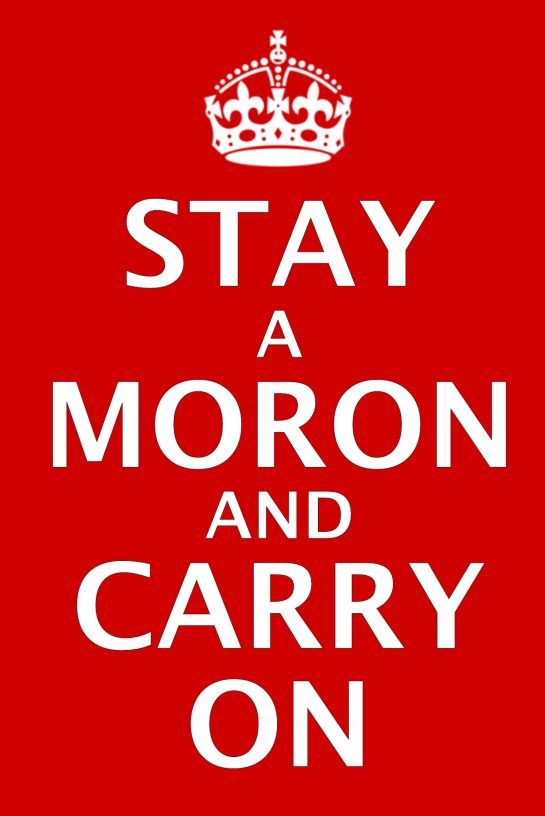Calendly. Bloody awful. Never again.
Monthly Archives: August 2021
Quickie: One-way Interviews
Yet more wrong things righter. Only sociopaths could image this is a good idea.
Quickie: New Policy
I’m adopting a new policy: only speaking re: work with CEOs. Let’s see where that takes us.
Quickie: Have You Tried It?
You may dismiss all my suggestions. I’m fine with that, btw. Progress is on you.
Just one question: for any given suggestion – have yout tried it? Opinions and what you think count for naught, compared to experimental evidence.
Quickie: Carry On
Quickie: Shortage of Talent
I occasionally remark that:
“There’s no shortage of talent, just a shortage of organisations that talent wants to work for.”
Never more true than right now.
Here’s a sanguine article which sheds some more light on the subject.
Every Freaking Time
Every Freaking Time
How internal recruiters, managers and HR people hire the wrong candidates. Every freaking time.
When hirers have no clear idea of what a company needs, candidates get hired on random criteria.
When hirers have no idea what makes e.g. software development work (or not), candidates get hired on a range of criteria other than “will this person be effective?”.
When hirers buy into the myth that individual ability is the key criterion, they’ll skip over those candidates with the ability to work within – and change – the existing system (the way the work works).
No surprise, then, that most times, hires hire the wrong candidates.
Alternatively…
Understand what the company needs from the new hire, now and more significantly six months to two years down the line. And yes, this implies some hard system 2 thinking.
Understand what makes software development work, and select on that basis. BTW As the whole software industry is unable to answer this question, good luck with this!
Understand Deming’s 95:5, and select system-savvy candidates. You do know about systems thinking, don‘t you?
– Bob
Further Reading
Antimatter Recruiting ~ Think Different blog post
Quickie: Go Your Own Way
You can go many ways – how about if you go your own way?
Second Think Different Weekly Tuesday Drop-in
Second Think Different Weekly Tuesday Drop-in
For our second Think Different Tuesday drop-in, we covered the following topics:
Quickie: How to Work with People You Don’t Agree with or Like or Trust
Radical Candour ~ Kim Scott
The Post Office Counters software scandal.
General chatting.
Next Week
Next week, amongst other things, we might be looking at some of my more contentious blog posts.
Feedback
For those who attended today: Would you be willing to answer two questions?:
- How well did the Drop-in meet your needs today?
- What might we change for next time to better attend to your needs? Thanks for dropping-in! 🙂
– Bob
Quickie: Your Real Job
Some time ago I wrote the post “Your Real Job“. I’ve been wondering if anyone took this post to heart and acted on it? How did that work out for you?
Quickie: Constant State of Ship
I’ve not seen the idea of “Constant state of ship” mentioned much in the past few years, so maybe it’s time for a quick reminder?
Quickie: Promises, Promises
Any time we are promised the Earth, expect mud.
Quickie: Antimatter Principle Modified
The Antimatter Principle invites us to:
“Attend to the needs of the Folks That Matter™“
We might choose to amend this to read:
“Attend to the needs of the Holons That Matter™”
This modification is brought to you courtesy of Adam Kahane and his book “Collaborating with the Enemy: How to Work with People You Don’t Agree with or Like or Trust“.
Quickie: The Software Crisis Continues
The Software Crisis continues, because it suits just about everybody to have it that way.
Quickie: Keep On Keeping On
People keep on doing what they’re doing because they have no idea what else to do.
Quickie: ZeeDee Invites Discussing Folks’ Needs
ZeeDee invites folks to discuss each others’ needs, especially the needs of the customer.
Indeed, getting “requirements” straight necessitates such discussions.
Kids Are Our Future
Kids Are Our Future
Invent the future. Do it today.
What kind of future are we inventing for the children?
Whence the “software industry”?
Children of the future Age
Reading this indignant page,
Know that in a former time
Love! sweet Love! was thought a crime.~ William Blake
– Bob
P.S. Would you want your children working in the software industry, as it is today?
Quickie: How to Work with People You Don’t Agree with or Like or Trust
I’m presently reading (well, listening to) Adam Kahane’s 2016 book “How to Work with People You Don’t Agree with or Like or Trust”. See his own introduction.
The books speaks to me because I’ve found myself in such situations many times throughout my career, most often choosing the “exit” option from his four options of “adapt, collaborate, force, exit”.
Why not choose to collaborate? Always my first choice, I’ve generally believed.that collaboration generally requires cooperation of some sort from “diverse others”. Maybe Adam’s “stretch collaboration” perspective will open up new opportunities for “collaborate”.
“Collaboration seems both imperative and impossible. What do we do?
“The reason such collaborations seem impossible is because we misunderstand collaboration. Our conventional understanding of collaboration is that it requires us all to be on the same team and headed in the same direction, to agree on what needs to be done and be able to get this done, and to do what the task demands of us. In other words, we assume that collaboration can and must be under control.
“But this conventional assumption is wrong. When we are working in complex situations with diverse others, collaboration cannot and need not be controlled.”
~ Adam Kahane
Who’s Afraid of the Big Bad Wolf?
Who’s Afraid of the Big Bad Wolf?
The wolf in question for this post being “Requirements”.
In a recent Quickie I presented Phil Crosby’s Four Absolutes of Quality. The first of these four absolutes being:
1. The definition of quality is: conformance to requirements.
Let’s unpack what Phil meant by “requirements”. His meaning was very different from developers’ and software folks’ typical understanding of the term.
Suppliers and Customers All Down the Line
In Phil Crosby’s world, everyone is both a supplier and a customer. “Upstream” folks supply parts, information or other things to their most immediate downstream customer(s). Each such supplier/customer relationship is mediated by a mutual understanding of, and agreement on, what the customer needs, and thus what the supplier recognises they must provide. Hence “Quality”.
And, by the way, reflecting the mental model of an organisation – stretching back upstream into the organisation’s supply chain, and downstream into its distributors and customers – as a “braided river” of value streams (see the image accompanying this post).
Mutually Agreed Interface Standards
It’s this mutual understanding that Phil calls “requirements”. Not some massive document with screeds of tedious detail. Not some specification of the supplier/customer “interface” written and imposed by some more-or-less clueless third party.
Fear
In my travels, I’ve seen folks of every stripe run a country mile from “requirements”.
Senior management don’t like the idea because they fear their freedom of action being constrained by such things. (Untrue, by the way).
Developers don’t like the idea because they fear being dumped-on by some requirements weenie who has a different – and often erroneous – idea of what the customer needs.
And most folks fear being corralled by a set of requirements that, even when accurately reflecting the needs of a customer, hem-in their freedom to supply what they like, rather than what’s needed.
How do the folks in your organisation regard the idea of requirements? Do “requirements” in your organisation look anything like the Crosby definition?
– Bob




